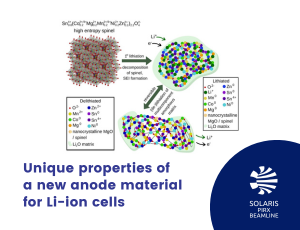
 Web Content Display
Web Content Display
SOLARIS centre
 Web Content Display
Web Content Display
 Web Content Display
Web Content Display
Unique properties of a new anode material for Li-ion cells.

Researchers from AGH, Shanghai Institute of Space Power-Sources and the University of Silesia have conducted research on a new anode material. The material features a simple synthesis method, excellent cyclic stability and good electrochemical performance. Experimental studies have been carried out using the technique of X-ray absorption spectroscopy (XAS on PIRX line), and the pioneering results have been published in the journal ACS Applied Materials & Interfaces.
Lithium-ion batteries are a ubiquitous technology for today’s society, being crucial especially for portable electronics and the electrification of transport. However, from a point of view of further growth of the Li-ion batteries market and emerging applications, new cells with an extended lifespan, improved safety, as well as higher energy and/or power density are indispensable. To achieve this goal, one of the most significant objectives is to replace the conventional graphite anode, working already at its theoretical limits, with other, better compounds. Although much higher capacities can be obtained by employing anode materials that store lithium based on different Li-storage mechanisms, as compared to graphite, new challenging issues have emerged regarding their application. The main one is poor stability during cycling (i.e. charging and discharging), resulting in the unacceptable capacity fade. Recently it has been proposed to combine two different Li-storage mechanisms within a single compound, benefiting from their advantages and confining the disadvantages. The so-called conversion-alloying materials (CAMs) have been proposed and developed. Despite the overall improved electrochemical properties of CAMs, their still insufficient cycling stability remains a significant problem. So far, the only possibility of improving cyclability was to use complex and expensive synthesis methods and additives, which are hard to scale and expensive, and because of that, the vast majority of them will never be used for commercial production.
When studying the literature, authors of the publication found that a novel group of materials, the so-called high-entropy oxides (HEOs), has brought particular attention in the field of materials science and is currently extensively studied all over the world. HEOs are materials containing numerous elements (typically five or more) in a ratio close to equimolar, resulting in the high configurational entropy of the such system (hence the name). Because of the presence of many constituents and complex interactions between them, these compounds may exhibit exceptional properties, which cannot be simply predicted by analyzing the components individually. For example, one such effect is the excellent cycling stability observed for HEOs when they are applied as anode materials in Li-ion batteries. The reasons for this behavior, however, have not been fully understood so far.
Maciej Moździerz, the first author of the publication says: “In our work, we decided to resolve the problem of the capacity fade of CAMs by developing a novel concept of application of the high-entropy approach to CAMs. We successfully created a new anode material for Li-ion batteries, Sn0.80Co0.44Mg0.44Mn0.44Ni0.44Zn0.44O4, characterized by the excellent cycling stability, as well as good electrochemical performance. Very importantly, it can be obtained using a simple synthesis method, without expensive additives, and therefore, is easily transferable to the industrial scale. Then, we wanted to take a step further and explain in details why exactly this material works very well, and how in particular the high-entropy approach ensures great stability. For this purpose, we had to use several experimental techniques allowing investigating battery materials at the atomic scale, including X-ray absorption spectroscopy experiments, which were possible thanks to the use of the research infrastructure of the National Synchrotron Radiation Centre SOLARIS.”
The scientists carefully studied the material at different charge/discharge states, corresponding to the amount of introduced lithium. All the investigations led to the conclusion that the Li-storage mechanism in the high-entropy anode material is significantly changed compared to the conventional oxides. They identified numerous interesting features, including the reversible lithiation of the amorphous (glassy-like) multi-component matrix, electrochemical activation of typically inactive magnesium, and excellent mixing of all the elements at the atomic scale maintained during battery charging and discharging.
“All those observations interpreted together can provide, for the first time, a detailed explanation of the origins of the excellent cycling stability of HEOs. Based on that, we could provide guidelines for the further development of CAMs as alternative anode materials for future Li-ion cells.” – summarizes prof. Konrad Świerczek.
RFigure 1. Schematic of the proposed Li-storage mechanism for the Sn0.8-ME5 conversion-alloying anode material. The initially disordered and distorted high-entropy spinel lattice decomposes during the first lithiation with a concurrent SEI film formation.
Written by: Maciej Moździerz, Konrad Świerczek
